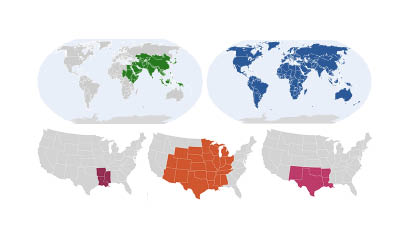
Population: Measuring Ecological Impact by Country
Population is a sticky subject. It’s personal, cultural and biological. It’s also complicated: The impact of parenting depends upon which part of the planet we live. As the Global Footprint Network (an organization that has developed a data-driven metric that tells us how close we are to the goal of sustainable living) explains, ecological footprints are dependent upon your home address, which is associated with government assistance, roads and infrastructure, public services and military expenses. In the Footprint Calculator, citizens of a country are allocated their share of these societal impacts. (Check out the calculator; it’s pretty cool.)
Tim De Chant presented this concept in 2011 with tighter boundaries in infographics that demonstrate how big a city would have to be to house the world’s 7 billion people. With these graphics, he shows how that one city of 7 billion would change, depending upon which real-life city it’s modeled after. As he writes, “If we all lived like New Yorkers, for example, 7 billion people could fit into Texas. If we lived like Houstonians, though, we’d occupy much of the conterminous United States.”
Recently, De Chant created new infographics to include what his previous work omitted: the land that it takes to support such a city. De Chant points out that “Cities’ land requirements far outstrip their immediate physical footprints. They include everything from farmland to transportation networks to forests and open space that recharge fresh water sources like rivers and aquifers.” De Chant has now illustrated how much land 7 billion would people need to live like the people of Bangladesh, India, Uganda, China, Costa Rica, Nepal, France, the United States and the United Arab Emirates.


